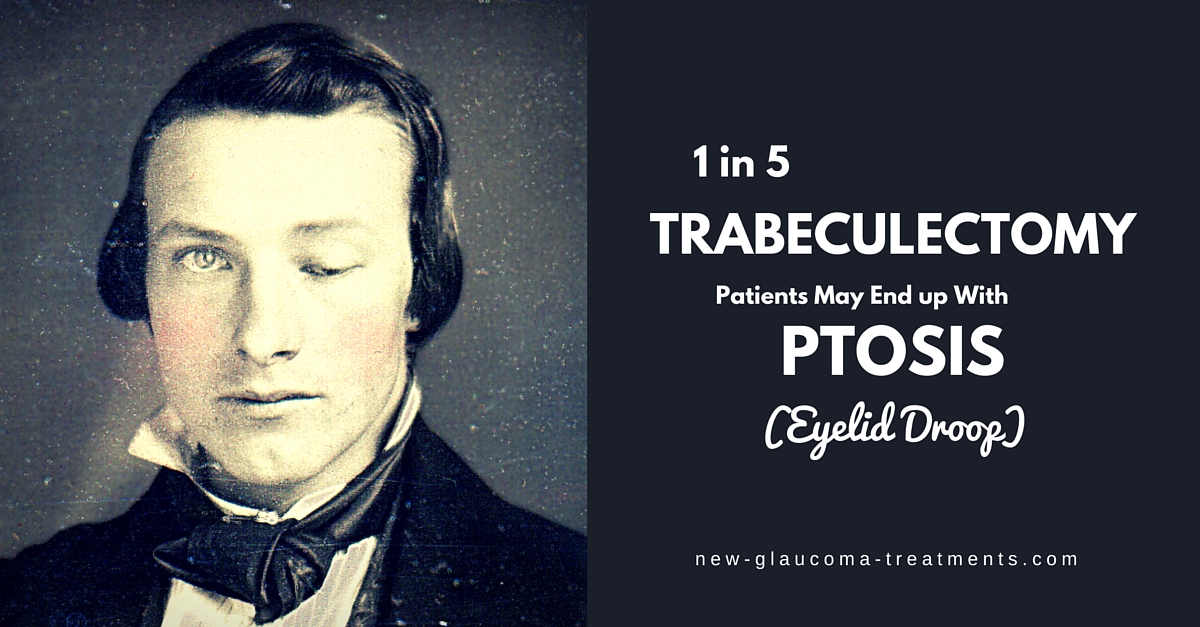
Trabeculectomy Lowers More Than Just Intraocular Pressure
Anyone who knows the term “trabeculectomy” understands that it is a glaucoma surgery intended to reduce the intraocular pressure (IOP). Most facing this surgery are also aware that trabeculectomy is associated with significant lifetime risk. Few, however, are likely told of a common cosmetic complication: lid droop.
Just how common is this complication? Turns out just under one in five patients who undergo trabeculectomy glaucoma surgery may end up with a significant eyelid droop (also called “ptosis”)[1]. Still, one might argue that as ptosis is not a vision-threatening complication it’s hardly worthy of discussing with every patient who is facing the prospect of glaucoma surgery. At least that seems to be the attitude of a fair number of glaucoma surgeons.
However, just because something is labeled “cosmetic” does not mean that it will have a negligible impact on the patient. Indeed, a recent study performed in the United Kingdom demonstrated that patients with a noticeable lid droop experienced a greater amount of anxiety and depression[2] Worth emphasizing: this study was performed in England. Just imagine what the results would have been had this study been done in the far more appearance-focused USA.
It is a challenge for glaucoma surgeons to discuss both potential vision-threatening as well as cosmetic complications of glaucoma surgery. Surgeons are expected not only to be skilled, but also to balance the constraints of limited time with the need to educate and inform. Nonetheless, even “cosmetic” side effects have the potential to substantially impact a person’s life. Therefore, I believe warning patients of a potential lid droop should be part of the patient-surgeon discussion prior to electing trabeculectomy as one’s glaucoma surgery.
References
- Naruo-Tsuchisaka A, Maruyama K, Arimoto G, Goto H. Incidence of Postoperative Ptosis Following Trabeculectomy With Mitomycin C. J Glaucoma. 2015;24:417–420.
- Richards HS, Jenkinson E, Rumsey N, et al. The psychological well-being and appearance concerns of patients presenting with ptosis. Eye. 2014;28:296-302.
Don’t delay getting checked for glaucoma.
Make an appointment with an eye doctor in your area now. If you live in the greater Los Angeles area and would like Dr. Richardson to evaluate your eyes for glaucoma call 626-289-7856 now. No referral required. Appointments are available, Tuesday through Saturday.
In The Same Series:
- Trabeculectomy Surgery For Glaucoma
- Why Trabeculectomy is the Most Common Glaucoma Surgery
- Risks of Trabeculectomy (Part 1 of 2)
- Risks of Trabeculectomy (Part 2 of 2)
- When Should Trabeculectomy Be Considered?
Related Articles:
- What Is The Big Deal About A Bleb?
- Is Trabeculectomy an Option After Canaloplasty?
- PhacoCanaloplasty™ vs Phacotrab
- 1 in 5 Trabeculectomy Patients May End up With Ptosis (Eyelid Droop)
- Trabeculectomy versus Canaloplasty (TVC study)
- Trabeculectomy Glaucoma Surgery After Canaloplasty
- Trabeculectomy Glaucoma Surgery (Part 3 of 12 of “What’s New In Glaucoma Surgery” Presentation)

David Richardson, MD
Medical Director, San Marino Eye
David Richardson, M.D. is recognized as one of the top cataract and glaucoma surgeons in the US and is among an elite group of glaucoma surgeons in the country performing the highly specialized canaloplasty procedure. Morever, Dr. Richardson is one of only a few surgeons in the greater Los Angeles area that performs MicroPulse P3™ "Cyclophotocoagulation" (MP3) glaucoma laser surgery. Dr. Richardson graduated Magna Cum Laude from the University of Southern California and earned his Medical Degree from Harvard Medical School. He completed his ophthalmology residency at the LAC+USC Medical Center/ Doheny Eye Institute. Dr. Richardson is also an Ambassador of Glaucoma Research Foundation.


